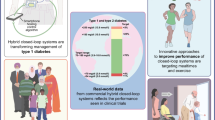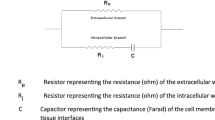Abstract
The study of blood-tissue exchange by the multiple indicator dilution technique often needs frequent sampling in the blood of the indicator dilution curves (IDC). Usually, this requires the use of a catheter supported by a pump. This causes a distortion in the IDC, which must be removed for proper interpretation of the data. A deconvolution-based methodology to remove IDC distortion is presented. First, the catheter impulse response is modelled by means of data obtained from a suitable experiment. Then the reconstruction of the blood IDC is tackled by a new nonparametric deconvolution algorithm, which provides (quasi) time-continuous signals and exploits statistically based criteria for the choice of the regularisation parameter. The methodology is applied to the removal of cathether distortion in studies of glucose blood-tissue exchange in the human forearm and myocardium.
Similar content being viewed by others
References
Beck, J. W. andArnold, K. J. (1977): ‘Parameter estimation in engineering and science’, (Wiley, New York).
Bertero, M. (1989): ‘Linear inverse and ill-posed problems’,Adv. Electron. Electron Phys.,75, pp. 1–120.
Bonadonna, R., Lehtovirta, M., Laurila, E., Vicini, P., Menotto, F. andGroop, L. (1995): ‘Transcapillary transfer of glucose in human skeletal muscle is not mediated by an insulin sensitive mechanism of facilitated diffusion’,Diabetes,44, Suppl. 1, p. 195A.
Carson, E., Cobelli, C., andFinkelstein, L. (1983): ‘The mathematical modelling of metabolic and endocrine systems’ (Wiley, New York).
Charter, M. K. andGull, S. F. (1991): ‘Maximum entropy and drug absorption’,J. Pharmacokinet. Biopharm.,19, pp. 497–520.
Commenges, D. (1984): ‘The deconvolution problem: fast algorithms including the preconditioned conjugate-gradient to compute a MAP estimator’,IEEE Trans. Autom. Control.,29, (3), pp. 229–243.
Cutler, D. J. (1978): ‘Numerical deconvolution by least squares: use of prescribed input functions’,J. Pharmacokin. Biopharm,6, (3), pp. 227–241.
De Nicolao, G., Liberati, D. andSartorio, A. (1995): ‘Deconvolution of infrequently sampled data for the estimation of growth hormone secretion’,IEEE Trans. Biomed. Eng.,42, pp. 678–687.
De Nicolao, G., Sparacino, G. andCobelli, C. (1997): ‘Nonparametric input estimation in physiological systems: problems, methods, case studies’,Automatica,33, (5), pp. 851–870.
Golub, G., Heath, M. andWahba, G. (1979): ‘Generalized crossvalidation as a method for choosing a good ridge parameter’,Technometrics,21, pp. 215–224.
Goresky, C. A. andSilverman, M. (1964): ‘Effect of correction of catheter distortion on calculated sinusoidal volumes’Am. J. Physiol.,207, pp. 883–892.
Hall, P. andTitterington, D. M. (1987): ‘Common structure of techniques for choosing smoothing parameters in regression problems’,J. Roy. Statist. Soc. Ser. B,49, pp. 184–198.
Hansen, P. C. (1992): ‘Numerical tools for analysis and solutions of Fredholm integral equations of the first kind’,Inverse Problems,8, pp. 849–872.
Landaw, E. M. andDiStefano, J. J. (1984): ‘Multiexponential, multicompartmental, and noncompartmental modelling. II. Data analysis and statistical considerations’,Am. J. Physiol.,246, pp. R665-R677.
Norwich, K. (1977): ‘Molecular dynamics in biosystems’ (Pergamon Press, UK).
Milnor, W. R. andJose, A. D. (1960): ‘Distortion of indicatordilution curves by sampling systems’,J. Appl. Physiol.,15, pp. 177–180.
Phillips, D. L. (1962): ‘A technique for the numerical solution of certain integral equations of the first kind’,J. Assoc. Comput. Mach.,9, pp. 97–101.
Sparacino, G. andCobelli, C. (1996): ‘A stochastic deconvolution method to reconstruct insulin secretion rate after a glucose stimulus’IEEE Trans. Biomed. Eng.,43, pp. 512–529.
Tikhonov, A. N. (1963): ‘Solution of incorrectly formulated problems and the regularisation method’,Soviet. Math. Dokl.,4, pp. 1035–1038.
Twomey, S. (1965): ‘The application of numerical filtering to the solution of integral equations encountered in the indirect sensing measurements’,J. Franklin. Inst.,279, pp. 95–109.
Veng-Pedersen, P. (1980): ‘An algorithm and computer program for deconvolution in linear pharmacokinetics’,J. Pharmacokinet. Biopharm.,8, pp. 463–481.
Verotta, D. (1993): ‘Estimation and model selection in constrained deconvolution’,Ann. Biomed. Eng.,21, pp. 605–620.
Vicini, P., Pasinato, S., Saccomani, M. P., Frascerra, S., Pecori, N., Ferrannini, E., Bonadonna, R. andCobelli, C. (1994): ‘A multi-region distributed model of glucose kinetics in the human myocardium’. Proceedings of the IFAC Symposium on Modelling and Control in Biomedical Systems, Galveston, Texas (Omnipress, Madison WI) pp. 229–230.
Author information
Authors and Affiliations
Rights and permissions
About this article
Cite this article
Sparacino, G., Vicini, P., Bonadonna, R. et al. Removal of catheter distortion in multiple indicator dilution studies: a deconvolution-based method and case studies on glucose blood-tissue exchange. Med. Biol. Eng. Comput. 35, 337–342 (1997). https://doi.org/10.1007/BF02534087
Received:
Accepted:
Issue Date:
DOI: https://doi.org/10.1007/BF02534087




